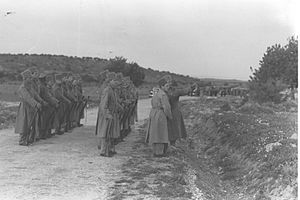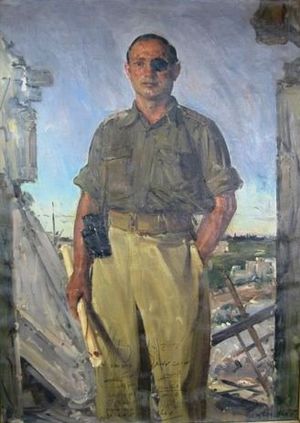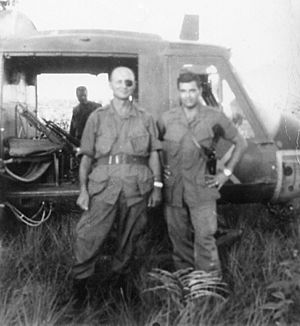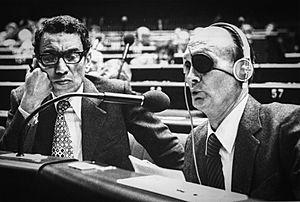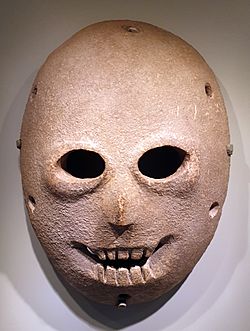Moshe Dayan facts for kids
Quick facts for kids
Moshe Dayan
|
|
|---|---|
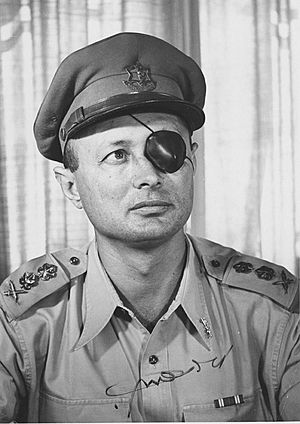
Moshe Dayan as Chief of General Staff
|
|
| Ministerial career | |
| 1959–1964 | Minister of Agriculture |
| 1967–1974 | Minister of Defense |
| 1977–1979 | Minister of Foreign Affairs |
| Faction represented in the Knesset | |
| 1959–1965 | Mapai |
| 1965–1968 | Rafi |
| 1968–1969 | Labor |
| 1969–1977 | Alignment |
| 1977–1981 | Independent |
| 1981 | Telem |
| Military roles | |
| 1953–1958 | Chief of General Staff |
| 1952 | GOC Northern Command |
| 1949–1951 | Head of Southern Command |
| Personal details | |
| Born | 20 May 1915 Degania Alef, Beirut Vilayet, Ottoman Empire (now Israel) |
| Died | 16 October 1981 (aged 66) Tel Aviv, Israel |
| Awards | Legion of Honour |
| Signature |  |
| Military service | |
| Allegiance | |
| Branch/service | |
| Rank | |
| Commands | Chief of General staff Southern Command Northern Command |
| Battles/wars | Arab Revolt in Palestine World War II 1948 Arab–Israeli War Suez Crisis Six-Day War War of Attrition Yom Kippur War |
Moshe Dayan (Hebrew: משה דיין; born May 20, 1915 – died October 16, 1981) was a famous Israeli military leader and politician. He was known worldwide as a symbol of the new state of Israel. He served as a commander during the 1948 Arab–Israeli War and later became the Chief of Staff of the Israel Defense Forces (IDF) from 1953 to 1958. He was also the Defense Minister during the Six-Day War in 1967, which made him very well-known.
In the 1930s, Dayan joined the Haganah, which was a Jewish defense force before Israel became a country. He lost an eye during a raid in Lebanon in World War II. Later, he became Defense Minister just before the 1967 Six-Day War. After the Yom Kippur War in 1973, he resigned due to criticism about the war's start. In 1977, he became Foreign Minister and helped negotiate the peace treaty between Egypt and Israel.
Contents
Early Life and Family
Moshe Dayan was born on May 20, 1915, in Kibbutz Degania Alef, near the Sea of Galilee. This area was then part of the Ottoman Empire and is now in Israel. His parents, Shmuel and Devorah Dayan, were Jewish immigrants from Ukraine. Degania Alef was the very first kibbutz, a type of farming community.
Moshe was named after Moshe Barsky, the first member of Degania to be killed in an Arab attack. Soon after, his family moved to Nahalal, the first moshav, which is a farming cooperative. Dayan attended an agricultural school there. He was a Jewish atheist and could speak Hebrew, Arabic, and English.
Military Beginnings
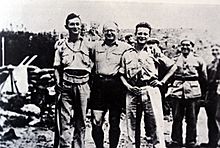
When he was 14, Dayan joined the Haganah, the Jewish defense force. In 1938, he joined the British-organized Jewish Supernumerary Police and led a small patrol. He admired the British officer Orde Wingate, and served under him in special night operations.
In 1939, Dayan and 43 other Haganah members were arrested by the Transjordan Frontier Force for having illegal rifles. They were sentenced to 10 years in prison but were released in 1941 after Chaim Weizmann intervened. After his release, Dayan joined an Australian-led reconnaissance team. They often went into Lebanon, dressed in traditional Arab clothes, to gather information.
The Eye Patch
On June 7, 1941, during the Syria–Lebanon Campaign, Dayan's unit secured two bridges over the Litani River. The next day, while he was on a roof using binoculars to scout, a French sniper's bullet hit his binoculars. This caused metal and glass fragments to fly into his left eye, severely damaging it. He lost the eye and had to wear the black eye patch that became his famous trademark.
Even after losing his eye, Dayan wanted to return to combat. He had surgery in Paris in 1947, but it was not successful. He later wrote that the disability caused him pain, and he felt like a "cripple without a skill." He preferred to stay home to avoid people's reactions to his eye patch.
Leading the Military
In 1947, Dayan joined the Haganah General Staff, focusing on Arab affairs and gathering information. In April 1948, his brother, Zorik, was killed in battle. Dayan was then put in charge of abandoned Arab property in Haifa. He made sure useful items went to the army and others were given to Jewish farming settlements. In May, he commanded the Jordan Valley sector and stopped a Syrian advance.
Battles and Commands
In June 1948, Dayan became the first commander of the 89th Commando Battalion. He was known for recruiting soldiers from other units, which caused some complaints. During Operation Danny, his battalion raided Lod. Later, his battalion captured Karatiya in the south.
In July 1948, David Ben-Gurion appointed Dayan as the military commander of Jewish-controlled areas of Jerusalem. He led two night operations there, but both failed. After the assassination of Count Folke Bernadotte in September 1948, Dayan imposed a curfew and arrested members of the Lehi group, who were believed to be responsible.
Dayan also negotiated cease-fire agreements for Jerusalem with Abdullah el Tell, the Jordanian military commander. He met with King Abdullah of Jordan several times in 1949 to discuss peace. Despite these talks, Dayan suggested to Ben-Gurion that the army should open the road to Jerusalem to access the Western Wall and Mount Scopus.
Southern Command and Border Policy
In October 1949, Dayan was promoted to major general and became commander of the Southern Command. A big challenge in the south was people crossing the border from the Gaza Strip and other areas. Dayan supported a "harsh" policy along the border. He allowed the Israeli Air Force to attack shepherds and Bedouin camps in some areas.
Dayan also started a policy of retaliation raids into Arab areas in response to attacks on Israelis. These raids sometimes resulted in civilian casualties, which led to international criticism. After a large attack on Qibya in 1953, where 69 people were killed, Israel changed its tactics to target military forces instead of civilian buildings.
Chief of Staff of the IDF
In December 1953, Dayan was appointed Chief of Staff of the IDF. This was one of Ben-Gurion's last actions as prime minister. As Chief of Staff, Dayan made big changes to the Israeli army:
- He made combat units stronger.
- He improved the Intelligence and Training Branches.
- He started a military academy for officers.
- He focused on special forces like the Air Force and commando battalions.
- He developed GADNA, a youth program for military training.
Dayan also helped set up Unit 101, a special unit for night-time cross-border raids. He was involved in planning many of these operations, which aimed to respond to attacks on Israelis.
Suez Crisis

Between 1955 and 1956, Dayan and Shimon Peres arranged for Israel to buy many weapons from France, including tanks and fighter jets. By November 1956, the Israeli army had many tanks.
Dayan believed war with Egypt was unavoidable and pushed for a preemptive attack. He personally commanded the Israeli forces in the Suez Crisis (also known as Operation Kadesh) in 1956, where Israel invaded the Sinai Peninsula.
During this time, Dayan gave a famous speech at the funeral of Ro'i Rutenberg, an Israeli killed by Egyptian soldiers. In his speech, Dayan spoke about the difficult reality facing Israel and the need for strength and readiness. He said, "We are a generation that settles the land and without the steel helmet and the cannon's maw, we will not be able to plant a tree and build a home."
Political Career
In 1959, after leaving the IDF, Dayan joined the Mapai party, led by David Ben-Gurion. He served as the Minister of Agriculture until 1964. In 1965, he joined Ben-Gurion in forming a new party called Rafi.
Six-Day War (1967)
In early 1967, as tensions grew, Prime Minister Levi Eshkol appointed Dayan as Defense Minister. This decision boosted public morale because Dayan was very popular. Although he wasn't involved in most of the war planning, he personally oversaw the capture of East Jerusalem during the Six-Day War in June 1967.
After the war, Dayan was incredibly popular in Israel and many saw him as a future Prime Minister. He was a strong voice in the government, arguing against giving back the lands Israel had captured in 1967. He once said he preferred Sharm-al-Sheikh (a town on the southern edge of the Sinai Peninsula) without peace, rather than peace without Sharm-al-Sheikh. However, he later changed his mind and played a key role in the peace agreement with Egypt.
1973 Yom Kippur War
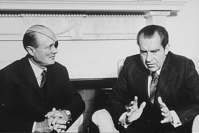
Dayan remained Defense Minister when Golda Meir became prime minister in 1969. He was still in this role when the Yom Kippur War began on October 6, 1973. Israel faced heavy losses in the first days of the war. Dayan was criticized for not ordering a full mobilization or a preemptive strike, as he thought Israel could win easily and didn't want Israel to appear as the aggressor.
After the initial defeats, Dayan's views changed. He suggested withdrawing to the Mitleh Mountains in Sinai and even pulling back from the Golan Heights. However, Chief of Staff David Elazar disagreed, and his strategy proved correct. Israel eventually broke through Egyptian lines, crossed the Suez canal, and surrounded the 3rd Egyptian Army. Israel also pushed back Syrian forces. The war ended with an Israeli victory, but it showed that Israel was not invincible. This eventually led to the peace treaty with Egypt.
Foreign Minister and Peace Efforts
The Yom Kippur War deeply affected Dayan. In 1977, he accepted the offer to become Foreign Minister in the new government led by Menachem Begin of the Likud party. Because of this, he was expelled from his own party, the Alignment.
As Foreign Minister, Dayan was very important in creating the Camp David Accords, a peace agreement between Israel and Egypt. He resigned in October 1979 because he disagreed with Begin about negotiations with the Palestinians. In 1981, he started a new political party called Telem.
Personal Life and Legacy
Moshe Dayan was married twice. His first wife, Ruth Dayan, divorced him in 1971. In 1973, he married Rachel Korem. His daughter, Yael Dayan, became a novelist and later a politician, serving in the Knesset and on the Tel Aviv City Council. One of his sons, Assi Dayan, was an actor and movie director.
Dayan died on October 16, 1981, in Tel Aviv, from a heart attack. He had been ill with colon cancer since 1980. He is buried in Nahalal, the moshav where he grew up.
Dayan was a complex and charismatic person. He had a deep love for the Jewish people and the land of Israel. In 1969, he spoke about how Jewish villages were built on the sites of former Arab villages, acknowledging the history of the land.
After Jerusalem was captured in 1967, Dayan ordered the Israeli flag to be removed from the Dome of the Rock. He gave control of the Temple Mount to the Waqf, a Muslim council. He believed the Temple Mount was more important to Judaism as a historical site than a holy one.
Dayan was also an author and enjoyed archaeology. He collected historical artifacts, sometimes with the help of his soldiers, which caused some controversy.
Awards and Decorations
|
|
|
|
Published Works
- Diary of the Sinai Campaign, 1967
- Living with the Bible: A Warrior's Relationship with the Land of His Forebears, 1978
- Story of My Life, 1976
- Breakthrough: A Personal Account of the Egypt-Israel Peace Negotiations, 1981
Images for kids
See also
 In Spanish: Moshé Dayán para niños
In Spanish: Moshé Dayán para niños


